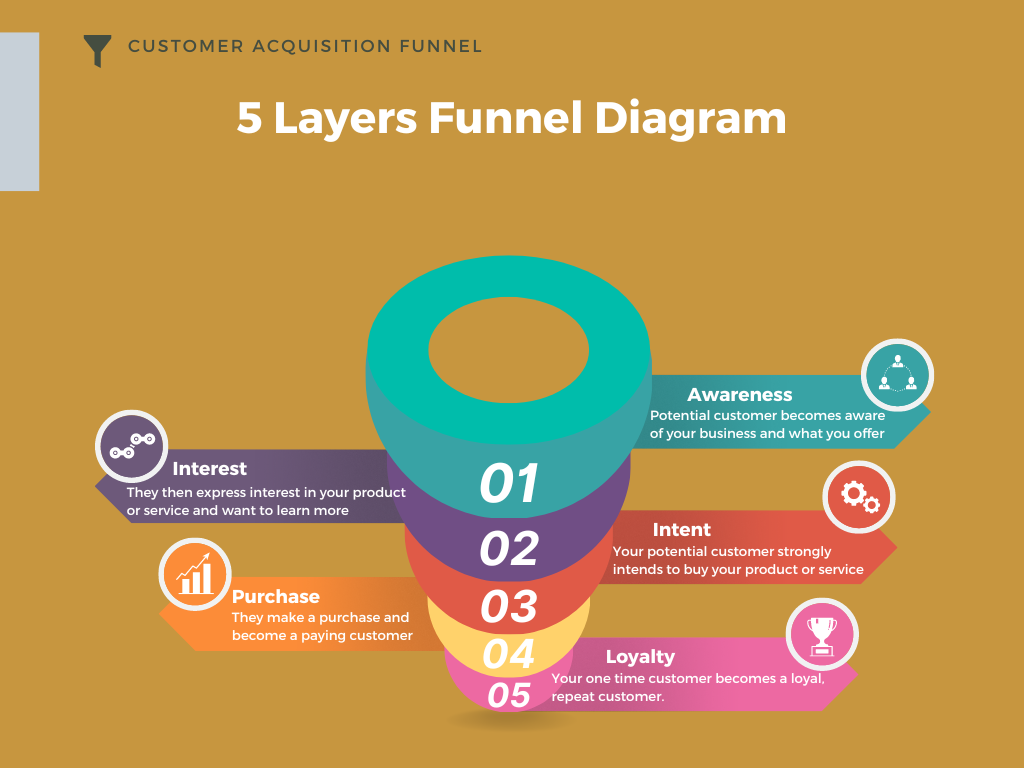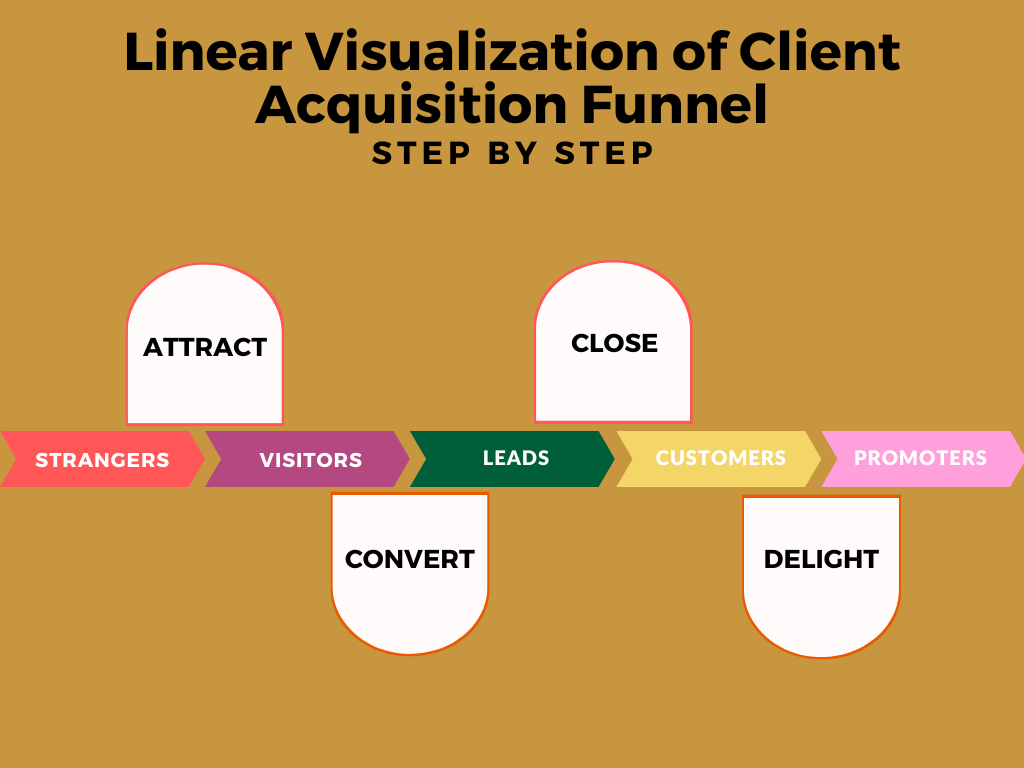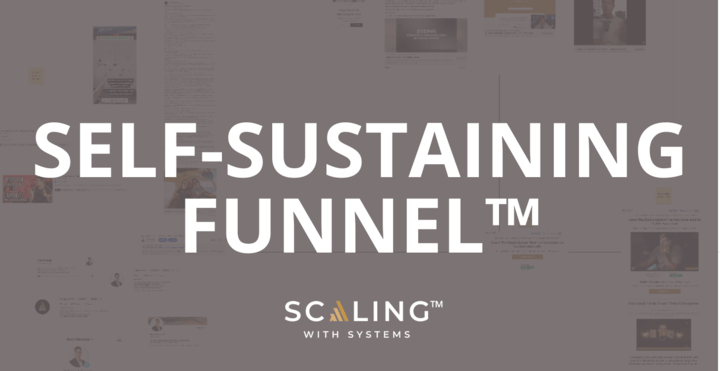Businesses ready to scale need a predictable system to convert leads.
But the fact is, customer acquisition is one of the most challenging and costly tasks a business faces.
Advertising online is effective, but only if you know how to do it. Otherwise, you can end up spending so much money that you’re barely making a profit.
This article will explore the strategies we use, and those that we help our clients with. These include digital marketing techniques like social media advertising, SEO content marketing, epic sales funnel creation, and more.
We’ll also look at why some more traditional methods are still valuable, like word-of-mouth referrals and networking events. When you use these cost-effective customer acquisition strategies, your business will grow fast.
What Is Customer Acquisition And Why Is It Important?
Customer acquisition refers to getting new customers to buy your product or service. It involves identifying, attracting, converting, and retaining customers.
Why is it important? Businesses need more customers to increase revenue and profitability. Without customers or clients, a business can’t function. This is why it is so important to have a system for getting new customers.
Just relying on the luck of people, maybe finding out about your products/services is a recipe for failure. Sure, you might get a few new sales here and there, but your business will never truly grow if you don’t have a consistent (and cost-effective) way to keep those customers rolling in.
So, you want to know how to acquire new customers (without paying so much money). Read on.
How To Acquire Customers: Marketing Vs Customer Acquisition
We’ll start with the definition of the difference between marketing and customer acquisition.
Marketing is the overall process of creating and promoting a product or service to potential customers. It involves researching your target audience, developing a unique selling proposition, and creating a marketing plan.
It is the HOW of brand awareness and sales. It’s how businesses put their offers out into the world, and the messaging that is used to express the value of these offers.
On the other hand, customer acquisition is the process of converting potential customers into paying customers. This can be through targeting customers with great marketing and creating compelling offers that people want to buy.
Marketing is that which is attempting to lead to customer acquisition. You can do this through a combination of online and offline methods. These include social media, email, content, networking, and referral marketing – just to name a few.
The key is to find the right mix of tactics that work best for your business and target audience.

What Is Customer Acquisition Cost (CAC)?
Customer Acquisition Cost (CAC) is basically the price a business pays for getting new customers. This cost is related to the marketing spend – how much the ads cost to bring in those new paying customers, for example.
CAC measures the cost of acquiring just one single customer. The marketing and sales expenses are both measured here (so, sales team salaries could be used in calculating CAC).
The formula for customer acquisition cost is:
CAC = [Cost of sales+cost of marketing]/New customers acquired
Say your company spent $400K on sales and $700K on marketing in the last fiscal quarter. This resulted in 1,100 new customers. If we calculate the customer acquisition cost (CAC) for that period, it would be $1K—($400K + $700K) divided by 1,100 = $1K.
Compare that figure against other key metrics like customer lifetime value (CLV) to learn if you can sustain the cost.
You need to optimize your customer acquisition system if you can’t afford that kind of money.
Customer Acquisition Funnel – Customer Journey
A customer acquisition funnel (also known as a customer journey) is a visual representation of a potential customer’s steps.
It’s like a roadmap that outlines the journey a person takes from being a stranger to your business to becoming a loyal customer. You must have a precise, robust, and impactful customer journey.
One that makes the potential customer more and more excited to buy from you and more convinced that it will change their lives in a meaningful way.
The typical stages of a customer acquisition funnel are:
- Awareness: Your potential customer becomes aware of your business and what you offer. This might be your business’s presence on your Instagram business account.
- Interest: They then express interest in your product or service and want to learn more. That would be reaching out for more information, heading to the website link in the profile, and browsing your offers.
- Intent: Your potential customer firmly intends to buy your product or service. They have been convinced to make the purchase through visuals, excellent copy, and social proof.
- Purchase: They make a purchase and become a paying customer.
- Loyalty: Your customer continues to purchase from your business and becomes a loyal, repeat customer.

Lead generation occurs at the top, lead acquisition occurs in the middle, and lead conversion occurs at the bottom of the funnel, with customer acquisition encompassing the entire funnel.
Another way to visualize it is through the “attract,” “convert,” and “close” phases, where strangers become visitors, leads, and customers.
Some organizations refer to customer acquisition only at the top and middle of the funnel, as conversion requires more customized strategies. But, for this post, customer acquisition refers to the entire funnel.

By understanding the customer acquisition funnel, businesses can better understand their target audience’s needs and motivations.
You’ll then be able to design sales and marketing efforts. They will effectively guide potential customers through the funnel and convert them into paying customers.
Take a look at our blog: Create Powerful Sales Funnels Strategy and B2b Lead Generation Strategies for more tips.
What Is Acquisition Marketing?
Acquisition marketing is crafting an advertising and promotion plan focusing on customers inclined to buy your products or services. These individuals are already familiar with your brand, making them ideal prospects for conversion.
These efforts are tailored to make them loyal customers over time.
It’s different from other types of marketing in that it focuses on targeting potential customers who already have some awareness of your brand and are seriously considering making a purchase.
The goal of acquisition marketing is to reach potential customers where they are. You can do this via TV, newspapers, social media, and customer referrals. Through carefully crafted messages that tap into the needs of these potential customers, you can then turn them into paying customers.
It’s about creating valuable, engaging, and enticing content that draws them in.
Businesses can sustain their growth by consistently acquiring new customers and ensuring long-term success. That’s why acquisition marketing needs to be the cornerstone of your business’s growth plan.
How To Acquire New Customers
Acquire new customers through well-planned marketing and outreach efforts. These include:
- Offering promotions or discounts: People love discounts and special promotions. If there’s a deal, there is a higher chance of purchase. People always want to know they’re getting the best price. With some urgency added in (like a 24-hour sale), people are highly motivated to purchase within that time frame. FOMO is a thing, even in business (especially in business).
- Networking and word of mouth: Get current customers to refer friends and family to your business. You can directly ask them for a referral or provide such a good experience that they naturally talk about how good your business is to their community. Networking also works well.
This includes attending events related to your industry and personally talking to people or presenting your business. Physical touchpoints (like meeting people in person) increase conversion rates. They are a very warm lead when they can talk to you in person.
- Online advertising: Use online advertising platforms, like Google AdWords or Facebook Ads. If you’ve created them effectively, the people who see your ads will be more inclined to click. That’s because well-targeted ads take into account search terms, demographics like income and gender, and other identifying factors. Learn the best ways to create ads in this article next.
- Search engine optimization (SEO): Optimize your website and content to rank higher in search engine results. You need to be more accessible to your audience. People rarely go to page 2 or 3 of Google results. You want to make it to the top page eventually. That requires patience and a very intentional SEO strategy. Also, don’t waste your time doing it yourself; your time is much more valuable and should be spent where it matters the most. Instead, delegate it to professionals—it requires technical knowledge.
- Content marketing: When creating content (YouTube videos, social media posts, free ebooks as lead magnets, or your blog), make it valuable. Don’t just create content for the sake of creating it; it should be helpful and impact your audience’s lives and decisions.
Your content must provide solutions, tips, information, and interesting facts and be engaging. This will keep your audience hooked and make your brand visible in the busy online world. With so many products and services trying to get people’s attention, you must find a way to stand out.
Also, creating helpful content will establish your business as an authority in your niche, making your prospects trust you and see value in your offerings.

What Are Acquisition Channels?
Acquiring customers is all about building relationships. An acquisition channel is the platform businesses use to do just that by connecting with prospective customers for the first time.
These channels can be anything from social media posts and paid ads to organic word-of-mouth introductions. Regardless of your chosen channel, be sure your first impression lasts.
No doubt, referral programs are an excellent way to save money. With 88% of businesses leveraging these programs, it’s evident that they can help companies maximize savings by reducing their budget for advertising.
You don’t need to pitch them your solution and convince them, as they’re already way down in the sales funnel. They are coming in hot (having already heard your brand’s message from someone they trust).
All you have to do is provide them with an excellent experience and convert them into repeat customers.
A blog could also be an acquisition channel. Create content that speaks directly to your target audience’s pain points or interests to capture their attention in a non-intrusive way. They’re happy to scroll through and read an article that gives them actionable tips (like you are reading this one right now).
Experimentation is critical to successful acquisition channels – you want to try out different methods and analyze their effectiveness to get the best return on investment (ROI). There are several ways to acquire customers, so don’t be afraid to take a multifaceted approach and see what yields the best results.
Organic Searches
Do some keyword research using tools like SEMRush, Open Site Explorer, and Ahrefs to understand which keywords your potential customers are likely searching for and optimize your content accordingly.
Once you have identified the best keywords, create engaging content around them that shows up in the SERPs when someone searches.
This includes blogs, infographics, videos, or other visual media that will capture potential customers’ attention and encourage them to click through to your website.
Also, your content must be optimized for various devices, such as mobile, tablets, and desktops. Otherwise, you might miss out on engaging with a significant target audience segment.
Plus, regularly update your SEO strategy based on analytics data to be sure that it remains relevant and effective in driving traffic.
Paid Searches
Paid search marketing, also known as pay-per-click (PPC) advertising, is the quickest way to get your content in front of potential customers on search engines.
With PPC, you can show up as a result for specific searches alongside organic results, giving you increased visibility and increasing your chances of being found.
Tools such as Google Keyword Planner and Microsoft Advertising equip your content and ads to perform better in search engine results.
Not only do these tools allow you to create targeted search ads, but they also enable you to place display advertisements on partner websites and with publishers outside the search network itself.
This makes paid search marketing a reliable way to reach more users with less effort than traditional organic optimization.
Pro tip: If your target audience is older, Microsoft Advertising can be a valuable tool for your PPC campaigns. As this demographic more often uses Internet Explorer as their default browser and Bing as their default search engine
Organic Social Media
Organic social media is a handy tool for growing brand awareness, humanizing your company, and showcasing content you have published elsewhere.
It provides the spark to ignite greater engagement with potential customers through other acquisition methods and allows your current customers and followers to actively promote your business.
Leverage organic social media’s virality to get your followers to share your content. That could potentially lead to exponential exposure for your business.
Examples of successful organic social media campaigns are all around us, ranging from funny cat pictures on Twitter to inspirational quotes on Instagram.
Get familiar with each social media platform, scout out the viral content, take inspiration, and implement it in your own content strategy to give your business the exposure it deserves.
Paid Social Media
Paid social media can be a great tactic for businesses, especially if they have a budget and want to see their content quickly seen by the right people.
With sponsored posts on Facebook, Twitter, and Instagram, users’ content can instantly be exposed to the right eyes without building up a loyal following. (But don’t sleep on that, too!)
Facebook Lead Ads are another way to advertise on social media, but with the added benefit of gathering customer information such as email addresses and names.
This allows businesses to quickly convert their followers into leads and grow their contact lists. (This is a valuable asset for long-term growth, as these contacts convert faster than usual methods of promoting your business).
Email Marketing
Email marketing involves sending targeted, personalized messages to a list of subscribers. The goal is to build relationships, increase brand awareness, and drive conversions.
To start an email marketing campaign, build a list of subscribers by offering something of value (a lead magnet) in exchange for their email addresses. This can be a newsletter, coupon, or free resource.
Then, send regular emails to this list to promote your products or services by sharing valuable content or offering special deals.
Say you want to market a service that helps generate new leads. In that case, send an email to potential clients. Use headings like “How to acquire more customers online.”
That way, you’ll get higher email open rates (due to catchy headlines) and more engagements, resulting in more acquired customers.
Use personalized, relevant messaging and offer value to subscribers to improve the success of their email marketing campaigns.
Referral Programs
Your current customers can become your best asset in acquiring new ones. Earn customer referrals to bring in new business, but it’s easier said than done.
You can’t just force your clients to refer others to you—you have to encourage them.
To encourage your current customers to bring you new business, set up a referral program with incentives such as credit, physical gifts, or monetary rewards for those who refer someone else. This works exceptionally well for B2C companies.
For B2B businesses, asking for direct customer referrals could be more effective.
Regardless of your chosen strategy, you must first offer something of value. Offer them something so delightfully amazing that they just want to share it with everyone they know!
Events
Events such as conferences, webinars, and trade shows can provide an invaluable opportunity to connect with potential customers and acquire new ones.
As these events are now mostly virtual, they simplify the capture of customer information. Attendees must register with their email address to attend, allowing you to get ahold of valuable data that might be difficult to obtain in person.
Interact with your prospects and sponsors from the comfort of your own home. If this is a new customer acquisition channel for your business, consider running a small webinar or virtual summit or renting out a booth at a larger event.
Also, use platforms like Meetup to increase the number of attendees at your events.
Traditional Advertising Channels
Traditional advertising channels include television, radio, and print. For example, you might run a television commercial during a popular show. You could also place an advertisement in a magazine their target audience is likely to read.
Traditional ways of advertising can also be more expensive and less specific than other ways of getting customers.
To succeed with traditional advertising, plan your campaign carefully. You need to pick the right channels for your target audience and make ads that make people want to learn more.

Ways To Acquire New Customers: Breaking Down Digital Acquisition Channels
SEO (Organic Acquisition Channel)
With proper SEO implementation, you’ll be able to get free traffic from Google, all with surprisingly low customer acquisition costs in the long run.
There’s no exact science to creating content to rank well in organic search, but there are proven methods you can use to optimize your content.
From adding relevant keywords to the post title to including alt text on images and transcripts for video and audio formats to linking internally within your site—the list goes on.
SEO is becoming a more popular customer acquisition option due to its cost-effectiveness and relative ease of implementation; 64% of marketers actively invested in SEO last year.
Here’s a quick overview of how SEO can help you improve your SERP rankings and help you reach more potential customers:
Keyword Research & Implementation
Know what exactly goes into optimizing your website for search engines. To do this, understand the basics of keywords and how they’re used in organic search results.
Keywords are terms used by people searching for specific products or services. When used correctly, these words indicate your website’s relevance when users type specific keywords into search engines like Google or Bing.
To help with keyword research and implementation, use online tools such as Google Keyword Planner or SEMrush.
These tools allow you to identify popular keywords related to your services or products and provide insights on how competitive or easy it will be to rank for them.
Also, many SEO tools offer advice on other aspects of SEO. An example would be title tags and meta descriptions. These text snippets appear in organic search results underneath the titles of individual web pages and their URL link addresses.
Link Building
Link building is one of the essential components of SEO since it determines how easily search engines can find and crawl through your website’s contents to index them within their databases.
Popular link-building techniques include guest posting on other sites related to yours and setting up backlinks among directories or blogs related to your industry/products/services. Another method is to create content that stands out, such as infographics or videos that other websites may want to link back from, etc.,
Content Creation & Management
Create content regularly so fresh material is added to your website(s). Not only does this help keep visitors engaged, but it also helps improve rankings since it provides an excellent signal towards websites being actively maintained, which rank higher than dormant ones.
Content pieces could range from informational blog posts about industry trends and news pieces to highly detailed guides about different topics related to products and services.
Schema Markup Usage
Another approach towards leveraging marketing efforts around SEO is by incorporating schema markups and microdata within websites so they show up more prominently across SERPs.
This helps search engines understand what exactly the content (page or post) is about in their own language, resulting in better rankings.
Blogging (Organic Acquisition Channel)
Bring potential customers to your websites by regularly writing and publishing high-quality blog posts. Once they are there, the information on your website can convert them into paying clients. (Granting that it’s compelling enough)
If you want to use blogging to acquire new clients, you can do the following:
- Choose suitable topics: Select relevant topics for the people you want to reach.
- Publish high-quality content: If you create well-written, well-researched blog posts, you can provide value to your target audience.
- Promote the blog: Share your blog posts on social media, email, and other channels to reach a wider audience and drive traffic to the blog.
How To Acquire New Clients: Video Marketing
For organic video marketing, you must make high-quality, exciting videos and share them on social media. Platforms like YouTube, Facebook, Instagram, TikTok, and LinkedIn are ideal.
Respond to viewers’ comments and questions to build relationships with their target audience and get them more interested in what you have to say.
Tools like social media analytics can be used to track and analyze how well videos do.
Paid video marketing means engaging ads showing how valuable a business’s products or services are.
Email Retargeting (Email Acquisition Channel)
Email retargeting is a cost-effective way to reach potential customers who have already shown an interest in your business’s products or services. It can help increase the chances of converting them into paying customers.
Here are some steps to help with email retargeting:
- Segment email lists: Based on the website’s behavior data, break down existing email lists into groups with similar interests and behaviors.
- Send targeted email campaigns: Send targeted email campaigns to each group. Those emails offer personalized content and promotions based on their interests and behaviors.
- Monitor results: Once your email process is online, monitor the open rates, click-through rates, and conversion rates of the email campaigns, and make adjustments as necessary.
Using Sponsored Content To Acquire Clients (Traditional Acquisition Channel)
Piggyback your way to success using someone else’s authority and audience through sponsored content. Here are some ways to do that:
- Sponsor a post on a high-authority website: Email some high-authority websites and ask them for a sponsored post. High-authority media websites are more open to accepting a sponsored post. That way, you’ll be able to skip all the effort you’d have to put in otherwise for SEO and rank in the SERPs. It’s also known as parasite SEO.
- Sponsor an influencer: It’s as simple as it sounds. Find an influencer in your niche and pay them to give a shoutout to your business, or even shoot a full-fledged ad by collaborating with them to feature in their videos.
Customer Spotlights (Referral Acquisition Channel)
A “customer spotlight” is a way to get new customers by focusing on their current customers. This can be done through various means, such as:
- Testimonials: Share customer testimonials on your website, social media, or marketing materials. This shows how others have benefited from your product or service.
- Case studies: Create detailed case studies that showcase how your business has helped customers solve a problem or achieve a goal.
- Customer interviews: Conduct interviews with your customers and share the results on your website or social media channels.
- Social media shoutouts: Share customer success stories on your social media channels and tag the customer in the post to increase visibility.
Use customer spotlights to get referrals and use the power of social proof and word-of-mouth marketing.
Show the success of your current customers to demonstrate how valuable your product or service is. This encourages others to become customers themselves by fostering trust in them.
Gated Content & Product Pricing To Acquire Customers
Gated content and product pricing are two ways businesses can acquire customers. You must find a balance between giving the customer value and making sure the business still makes money.
The key is to find the right pricing strategy. This allows the business to acquire customers and build a sustainable revenue stream.
- Gated content: This is a marketing strategy where you would offer valuable content. This can be an eBook, white paper, or webinar. Offer these in exchange for a customer’s contact information, such as their email address or phone number.
Attract potential customers and build relationships with them over time by providing valuable content.
- Product pricing: Product pricing can also be used to acquire customers by offering a lower price point for a limited time. This entices new customers to try the product. Get customers in the door, build a relationship, and encourage them to make a full-priced purchase in the future.
How To Acquire New Customers: Affiliate Programs
Affiliate programs can be cost-effective for new client acquisition. With affiliate programs, businesses only pay commissions when a sale is made. Affiliates can also bring in new customers that the business may not have reached otherwise.
Choose the right affiliates and set clear terms and conditions for the affiliate program. This ensures that both you and the affiliates are happy with the partnership.
You would pay affiliates a commission for referring new customers to their website or product.
Here’s how affiliate programs work:
- Creates an affiliate program and recruits affiliates to promote your product.
- The affiliates promote your offerings to their audience using a unique referral link.
- The affiliate earns a commission when a customer clicks on the referral link and makes a purchase.
FAQs About How To Acquire Customers
What are customer acquisition strategies?
Customer acquisition strategies are plans companies make to attract and gain new customers. The main goal is to find and attract new customers to the business. They include email marketing, advertising on social media, and creating informative content. All of these can attract new customers.
What is the purpose of customer acquisition?
The purpose of customer acquisition is to bring new customers into a business, increase the customer base, and grow the company’s revenue. By acquiring new customers, a business can reach more people, raise brand awareness, and have a more diverse group of customers.
Why is acquiring clients important?
Acquiring clients is essential because it helps businesses grow and become more successful. The more clients a business has, the stronger and more successful it will be. Acquiring clients also allows companies to build brand awareness.
Final Thoughts On Acquiring New Clients
Acquiring customers doesn’t need to be an expensive and time-consuming endeavor.
Whether you choose word-of-mouth advertising or leverage digital marketing, there is always an affordable way to reach your target audience.
Ready to start growing your customer base? Scaling With Systems has an excellent record of working with new and existing businesses to help them grow. Book a free consultation call to get the ball rolling on your business acquiring new clients.



